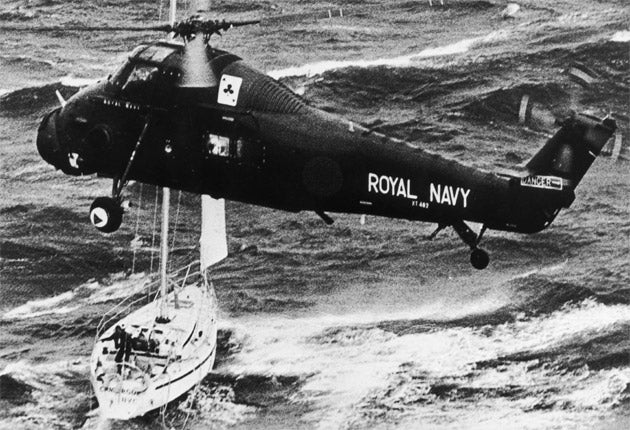Sailing: 'We will certainly remember 1979 when we're out there'
As the Fastnet anniversary is marked in Cowes, Stuart Alexander meets amateurs who survived to tackle the race again

Support truly
independent journalism
Our mission is to deliver unbiased, fact-based reporting that holds power to account and exposes the truth.
Whether $5 or $50, every contribution counts.
Support us to deliver journalism without an agenda.

Louise Thomas
Editor
When he was 17, Kieron Kennedy sailed in his first Fastnet race. It was 1979, and as he plotted a course from Cowes to the southern tip of Ireland and back to Plymouth, a storm was brewing. Before he returned, 15 people would die and four more would be lost in the storm that hit the 300-boat fleet.
Today, Kennedy's thoughts will be on the memorial service taking place at Holy Trinity Church in Cowes, where the lost adversaries and friends will be remembered on the 30th anniversary of sailing's deadliest tragedy. He cannot be there in person, as he has preparations to make. For on Sunday, at midday, Kennedy will set off on the Fastnet race again – this time with his daughter Betsy as crew.
Just as 30 years ago, the race attracts professional crews on purpose-built racing yachts (including 19 international Admirals' Cup teams) but the far bigger contingent will be made up of amateurs on what are essentially converted cruisers. The disaster has not diminished its appeal in either camp.
Kennedy did not finish the course in 1979 – only 85 of 306 boats did. The boat he was on had run for cover in Crosshaven to find urgent medical help for the skipper, Rodney Barton.
"I don't really know what happened, as I was below trying to keep warm, but someone noticed that the skipper was in a top bunk and dripping blood on to the man below," he says. "He had been badly cut and was bleeding profusely. It was not until we reached Crosshaven that we realised all that was going on and even then we were thinking of restarting. The doctor said that Rodney had lost far too much blood. 'You're not going anywhere,' he ordered. We stayed put."
This year, Kennedy will be on a 47-foot boat called Exocet Strike with owner John Dyer and his wife Stella. It is his fourth Fastnet, and the technology available – Exocet Strike has all manner of satellite communication and navigational kit on board, in contrast with Checkmate II, the 34-foot yacht he was on in 1979, which had a crackly VHF and an ordinary radio which only worked close to land – makes it a less daunting experience than it once was.
Nonetheless, he is sure to be reminded of that treacherous Monday night in August 1979, he says. "We will certainly be remembering it when we are back out there," he says.
"But everything is dramatically different now and we should not be caught by surprise. We could even have a hot shower going round the rock. I helmed round it in 2001 and that put a chapter to bed. And I love the moonlit nights with the spinnaker up, or seeing the pods of dolphins. I am excited."
Betsy, too, cannot wait. "As my dad was in the '79 Fastnet the race has always been significant to me and I have always wanted to take part. I would not want to do this race without my dad on board."
Kennedy races with his wife Lu out of West Hoe Sailing Club some evenings and at weekends in the family's 26-foot Trapper 300. Betsy races in a rival boat. "She hasn't beaten us yet, but it won't be long," says Kennedy. "We know we're not going to win, not even close, but it would be nice to be back in time for the Thursday night race in Plymouth."
One man who may be back somewhat quicker is Paul Standbridge, who will be covering the 608 miles for the 17th time. He has taken part in every Fastnet Race since 1975 (when he was 16) – except the one in 1979. Since then, he has raced round the world five times in the Whitbread and Volvo races, once as skipper, been in four America's Cups if you count the abortive attempt by Peter de Savary to ram-raid the 1988 mis-match between San Diego and Auckland, and has just been recruited by the Sultanate of Oman to run a 105-foot trimaran training programme.
Nonetheless, he can understand the terror that must have gripped competitors in 1979. Asked at the end of what he described as "one of the most gnarly ocean legs" he has ever done, from Punta del Este, Uruguay, to Fremantle, Western Australia, if he had at any time been frightened, he replied: "Frightened, no not frightened, fucking terrified.
"Generally I am not scared of it, and when it's quite scary you are usually preoccupied, but you have to have a very healthy respect. And everyone crossing the start line wants to win."
Standbridge will be one of three watch captains – the other two are Brad Jackson and Mark Thomas – on the 100-foot Leopard. They have enough electronics and computer power to put a man on the moon. The boat has done 30,000 miles this year, including twice across the Atlantic.
Leopard, with Standbridge on board, set the record of 44 hours in the last Fastnet in 2007. Standbridge is raring to go. "I'll enjoy this Fastnet as much as my first. I love sailing along the Dorset coast and feel that, of the big three, Fastnet, Newport to Bermuda, and Sydney-Hobart, that the Fastnet is more technically demanding."
Not as demanding now as it was in 1979, thankfully.
Subscribe to Independent Premium to bookmark this article
Want to bookmark your favourite articles and stories to read or reference later? Start your Independent Premium subscription today.
Join our commenting forum
Join thought-provoking conversations, follow other Independent readers and see their replies
Comments